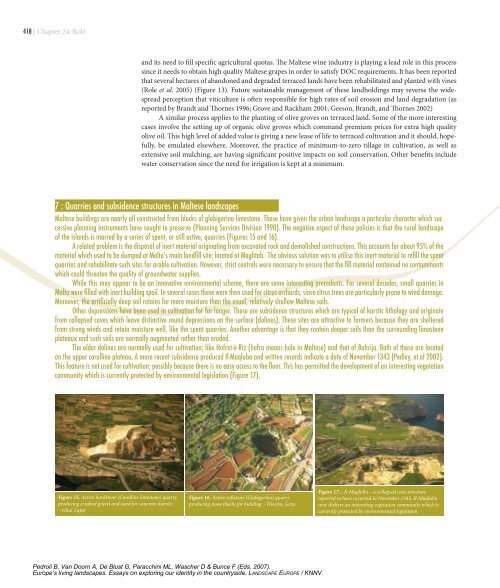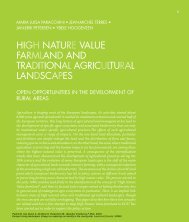The Terraced landscapes of The MalTese Islands - Landscape Europe
The Terraced landscapes of The MalTese Islands - Landscape Europe
The Terraced landscapes of The MalTese Islands - Landscape Europe
Create successful ePaper yourself
Turn your PDF publications into a flip-book with our unique Google optimized e-Paper software.
1 | Chapter 24: Rolé<br />
7 : Quarries and subsidence structures in Maltese <strong>landscapes</strong><br />
Maltese buildings are nearly all constructed from blocks <strong>of</strong> globigerina limestone. <strong>The</strong>se have given the urban landscape a particular character which successive<br />
planning instruments have sought to preserve (Planning Services Division 1990). <strong>The</strong> negative aspect <strong>of</strong> these policies is that the rural landscape<br />
<strong>of</strong> the islands is marred by a series <strong>of</strong> spent, or still active, quarries (Figures 15 and 16).<br />
A related problem is the disposal <strong>of</strong> inert material originating from excavated rock and demolished constructions. This accounts for about 95% <strong>of</strong> the<br />
material which used to be dumped at Malta’s main landfill site; located at Maghtab. <strong>The</strong> obvious solution was to utilise this inert material to refill the spent<br />
quarries and rehabilitate such sites for arable cultivation. However, strict controls were necessary to ensure that the fill material contained no contaminants<br />
which could threaten the quality <strong>of</strong> groundwater supplies.<br />
While this may appear to be an innovative environmental scheme, there are some interesting precedents. For several decades, small quarries in<br />
Malta were filled with inert building spoil. In several cases these were then used for citrus orchards, since citrus trees are particularly prone to wind damage.<br />
Moreover, the artificially deep soil retains far more moisture than the usual, relatively shallow Maltese soils.<br />
Other depressions have been used in cultivation for far longer. <strong>The</strong>se are subsidence structures which are typical <strong>of</strong> karstic lithology and originate<br />
from collapsed caves which leave distinctive round depressions on the surface (dolines). <strong>The</strong>se sites are attractive to farmers because they are sheltered<br />
from strong winds and retain moisture well, like the spent quarries. Another advantage is that they contain deeper soils than the surrounding limestone<br />
plateaux and such soils are normally augmented rather than eroded.<br />
<strong>The</strong> older dolines are normally used for cultivation; like H<strong>of</strong>ret-ir-Riz (h<strong>of</strong>ra means hole in Maltese) and that <strong>of</strong> Bahrija. Both <strong>of</strong> these are located<br />
on the upper coralline plateau. A more recent subsidence produced Il-Maqluba and written records indicate a date <strong>of</strong> November 1343 (Pedley, et al 2002).<br />
This feature is not used for cultivation; possibly because there is no easy access to the floor. This has permitted the development <strong>of</strong> an interesting vegetation<br />
community which is currently protected by environmental legislation (Figure 17).<br />
Figure 15. Active hardstone (Coralline limestone) quarry<br />
producing crushed gravel and sand for concrete slurries<br />
– Ghar Lapsi<br />
and its need to fill specific agricultural quotas. <strong>The</strong> Maltese wine industry is playing a lead role in this process<br />
since it needs to obtain high quality Maltese grapes in order to satisfy DOC requirements. It has been reported<br />
that several hectares <strong>of</strong> abandoned and degraded terraced lands have been rehabilitated and planted with vines<br />
(Role et al. 2005) (Figure 13). Future sustainable management <strong>of</strong> these landholdings may reverse the widespread<br />
perception that viticulture is <strong>of</strong>ten responsible for high rates <strong>of</strong> soil erosion and land degradation (as<br />
reported by Brandt and Thornes 1996; Grove and Rackham 2001; Geeson, Brandt, and Thornes 2002)<br />
A similar process applies to the planting <strong>of</strong> olive groves on terraced land. Some <strong>of</strong> the more interesting<br />
cases involve the setting up <strong>of</strong> organic olive groves which command premium prices for extra high quality<br />
olive oil. This high level <strong>of</strong> added value is giving a new lease <strong>of</strong> life to terraced cultivation and it should, hopefully,<br />
be emulated elsewhere. Moreover, the practice <strong>of</strong> minimum-to-zero tillage in cultivation, as well as<br />
extensive soil mulching, are having significant positive impacts on soil conservation. Other benefits include<br />
water conservation since the need for irrigation is kept at a minimum.<br />
Figure 16. Active s<strong>of</strong>tstone (Globigerina) quarry<br />
producing stone blocks for building - Dwejra, Gozo<br />
Pedroli B, Van Doorn A, De Blust G, Paracchini ML, Wascher D & Bunce F (Eds. 2007).<br />
<strong>Europe</strong>’s living <strong>landscapes</strong>. Essays on exploring our identity in the countryside. LANDSCAPE EUROPE / KNNV.<br />
Figure 17.– Il-Maqluba – a collapsed cave structure<br />
reported to have occurred in November 1343. Il-Maqluba<br />
now shelters an interesting vegetation community which is<br />
currently protected by environmental legislation




